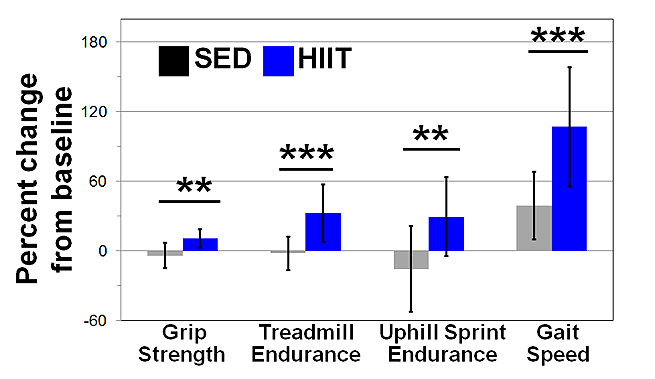
Purpose: Those over the age of 65 are the fastest growing segment of the population in industrialized nation. Inactivity is a killer in this age group, leading to poor strength and endurance, disability, loss of independence and greater susceptibility to major diseases such as cancer, heart disease, and obesity. Exercise can help – but few participate – leading to Scientific AmeriKen’s interest in an important scientific question, “How little exercise can we do and still get something out of it?”. Perhaps, a few minutes a couple times a week can prolong health and this could increase participation. In this experiment, Scientific AmeriKen and the team use a 10-minute, 3-day-a-week high intensity interval training regimen in aged mice, approximately equivalent to 65-year old humans, and explore if this short exercise program is safe, builds muscle, and improves function, or in other words – if exercise still gets the job done in the old-timers! Hypothesis: As there are many over the age of 100 that are competitive athletes, we anticipate exercise, even short regimens, can still be beneficial in older organisms – including mice. It was the hypothesis of this experiment that a 4-month long HIIT program will increase the physical abilities of these old critters. Methods: Mice were trained on how to use a mouse treadmill as well as the following physical performance tests of the mouse Olympics: A grip strength test (the mouse grabs and pulls a grid away from a force meter), a level and an uphill treadmill run to exhaustion, a gait speed test (time for a mouse to walk 1 meter), an open field activity test (the distance a mouse moves in an square box – since mice like to explore), and a rotarod test (the length of time a mouse stays on a cylinder that spins faster and faster) to test balance and coordination. |

|
Results: The experiment lasted for 4 months with tests at the beginning (baseline) and the end of the experiment to examine all the different aspects of physical performance. The figure below indicates the percentage change from baseline in 4 of the tests that the mice improved. These include grip strength, flat and uphill treadmill performance, and gait speed. The mice did not improve in the rotarod or in their open field explorations.
Conclusions: This experiment shows that 4 months of a 10-minute, 3-day-a-week exercise plan increases strength and endurance in older mice. Interestingly, the improvement was not across the board as rotarod was not better (which tests balance and coordination in mice) nor was open field (suggesting the mice lacked motivation - possibly from being tired from doing all that exercise?). One important note - the increase of gait speed is a very positive sign since slow walking speed is an indicator of frailty - a condition of being more susceptible and less resilient to health challenges. Also, none of the mice died or were injured during the experiment. What is most exciting about these findings is that exercise, even a little bit, has benefits - even for old mice -- which suggest old humans now have no excuse to skip out on the morning routine! To learn more about this study click here to view the original study, or here and here to view articles discussing this study from the New York Times, or here to view a local news video report on this study. Also to discuss this story in greater detail - visit Science Chat Forum! |
 The HIIT exercise program is 10-minutes on an uphill treadmill and features a 3-minute warm-up, followed by 4 intervals of 1-minute fast, 1-minute slow. The intensity is tailored to the ability of each mouse, and increases every two weeks from there.
The HIIT exercise program is 10-minutes on an uphill treadmill and features a 3-minute warm-up, followed by 4 intervals of 1-minute fast, 1-minute slow. The intensity is tailored to the ability of each mouse, and increases every two weeks from there. 